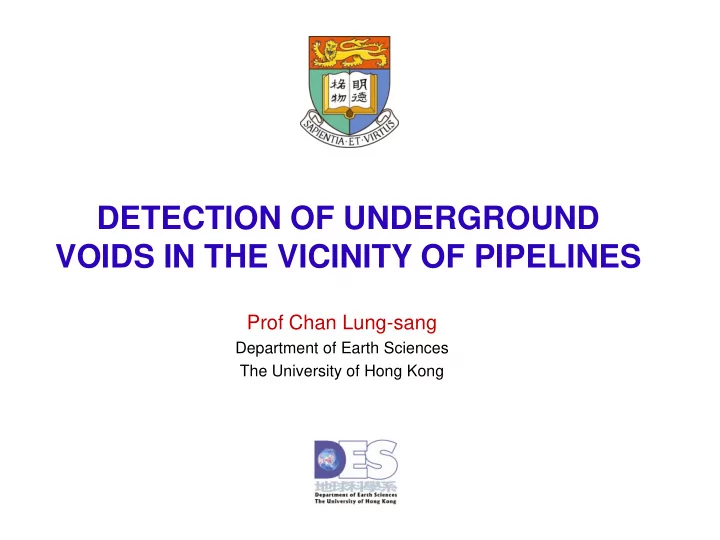

DETECTION OF UNDERGROUND VOIDS IN THE VICINITY OF PIPELINES Prof Chan Lung-sang Department of Earth Sciences The University of Hong Kong
Engineering Geophysical Methods Mechanical - seismic methods, surface wave dispersion, downhole seismic, acoustic televiewer, microgravity, gamma density and neutron porosity, hydro-fracturing, ultrasonic systems, impact echo Electrical - resistivity, self potential, induced polarization, electrical cylinder Electromagnetic - ground penetrating radar, crosshole radar, locators, electromagnetic, conductivity meter, permittivity Magnetic – magnetometer, locator Radiometric – natural gamma spectroscopy Thermal – thermography, infrared thermography
Void detection using geophysical methods (HK experience) • Microgravity: specifically for subsurface caverns • GEO Geophysical Site Characterisation Study Phases 1 & 2 (1995-97): GPR, seismic, EM and Resistivity imaging • Site trial experiment in Tai Po 1995: GPR • Various attempts; DSD 2013 trials in Kowloon Bay and Sha Tau Kok Road
Factors to be considered in selection of methods: 1. Ability to identify contrasting physical properties between the void and surrounding ground; 2. Non-invasive; 3. Ability to produce a continuous section; 4. Fast and inexpensive; 5. The method should give some indications on the depth, size and extent of the voids; 6. No significant disruption to traffic; 7. Not affected by electromagnetic interferences and radio noises in city.
Effectiveness Ratings of Various Surface Geophysical Techniques in Void Detection WSD GEO Technos DSD Reynolds Methods High-speed adaptability (2010) (1997) (1997) (2004) (2009) Seismic refraction C B B Yes, land streamer Seismic reflection, P- C B B B Yes, land streamer wave Seismic reflection, S- C Yes, land streamer wave Surface wave spectral B A C A Yes, land streamer analysis Surface wave B Maybe reflectometry Microgravity B A B No Frequency domain EM B B C B Yes Time domain EM C A C C Yes Ground penetrating A A A B A Yes, air horne radar Electrical resistivity A A B C A Yes, OhmMapper Self potential B B No Magnetic methods B C Yes Infrared thermography C C C B No Gamma density C C No Sonar method B Yes
Electrical and electromagnetic methods applications: soil resistivity: subsurface detection of changes in conductivity • Ground profile • Voids and moisture zone • Water table • Clay layers • Contaminated ground • Metallic objects ELECTRICAL SURVEY
Drainage Service Department, HKSAR, 2013 Field survey to detect existence of voids and utilities – electromagnetic and electrical resistivity measurements Consultant: Black & Veatch Water Geophysics Contractors: EGS (Asia) Limited, HKU
Frequency-domain EM method: Depth and size of the conductor affect the amplitude of the secondary field. Conductivity of the conductor affects the ratio of in-phase to out-of-phase amplitudes (A R /A I ), a good conductor having a higher ratio Credit: Northwest Mining Association and Klein
Electrical imaging method: A set amount of current in injected into the ground through a pair of current electrodes Potential differences between a pair of potential electrodes are measured with a resistivity meter Electrodes are moved to achieve various depth of penetration Resistivity section
1st Site Trial at Kowloon Bay
EM results from Area A, Kowloon Bay Site General findings: High negative in- phase variations and polarity reversal resistivity values Trend axis aligned with buried pipes
Resistivity results from Kowloon Bay Site General findings: Resistivity Section, Line A No particular resistivity anomalies attributable to buried pipes and voids Resistivity Section, Line B
HKU Resistivity survey in Area B
HKU Resistivity survey in Area B, Kowloon Bay Site
Resistivity results from Area B, Kowloon Bay Site (HKU) General findings: Prominent negative resistivity zone likely associated with buried pipes Method works better when survey line is perpendicular to buried utilities
2 nd Site Trial at Sha Tau Kok Road
EM results from Sha Tau Kok Road Site
EM results from Sha Tau Kok Road Site General findings: High negative in- phase variations and polarity reversal resistivity values aligned with survey line Probably due to buried pipes and cables
Resistivity results from Sha Tau Kok Road Site General findings: Multiple resistivity anomalies identified No particular evidence they were voids-induced
Summary of Findings The geophysical trials were successful but did not detect convincingly underground voids in the vicinity of underground pipes due to site constraints; The geophysical methods may plausibly produce useful results only at very favourable site conditions; The methods should be regarded as indicative measures and not for definitive determination.
Alternative geophysical methods GSSI air horne system Chen and Scullion, Geophysical Testing Journal, 2010 GEOVision system
Void detection using Land Streamer (Overseas Cases) Van der Veen et al., Geophysics, 2001
Ohmmapper Surveys Prof YH Wang, Univ of Science & technology, HK
Way Forward • Recent development of the Ohmmapper and Land Streamer, respectively for electrical resistivity and seismic reflection survey, may enable field surveys to be conducted in a mobile and fast manner. Their efficacy for detecting underground voids in Hong Kong is uncertain. • A rational way to proceed with the survey is to design a control, trial site for testing the feasibility of the methods.
Thank You! chanls@hku.hk Department of Earth Sciences, University of Hong Kong
Recommend
More recommend